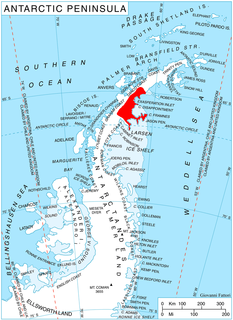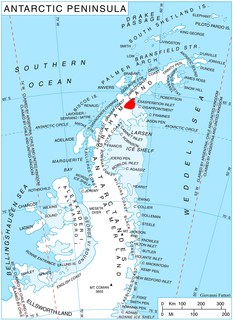
The Queen Elizabeth Range is a rugged mountain range of the Transantarctic Mountains System, located in the Ross Dependency region of Antarctica.

The Deep Freeze Range is a rugged mountain range, over 128 km (80 mi) long and about 16 km (10 mi) wide, rising between Priestley and Campbell glaciers in Victoria Land, Antarctica, and extending from the edge of the polar plateau to Terra Nova Bay. Peaks in the low and mid portions of the range were observed by early British expeditions to the Ross Sea.

The Usarp Mountains is a major Antarctic mountain range, lying westward of the Rennick Glacier and trending N-S for about 190 kilometres (118 mi). The feature is bounded to the north by Pryor Glacier and the Wilson Hills. Its important constituent parts include Welcome Mountain, Mount Van der Hoeven, Mount Weihaupt, Mount Stuart, Mount Lorius, Smith Bench, Mount Roberts, Pomerantz Tableland, Daniels Range, Emlen Peaks, Helliwell Hills and Morozumi Range.

Laws Glacier is a confluent glacier system which flows into Marshall Bay on the south coast of Coronation Island, in the South Orkney Islands off Antarctica. It was surveyed in 1948–49 by the Falkland Islands Dependencies Survey (FIDS), and was named by the UK Antarctic Place-Names Committee for Richard M. Laws of the FIDS, leader and biologist at Signy Research Station in 1948 and 1949, and at South Georgia in 1951.

Flask Glacier, is a gently-sloping glacier, 25 nautical miles long, flowing east from Bruce Plateau to enter Scar Inlet between Daggoo Peak and Spouter Peak in Graham Land, Antarctica. The lower reaches of this glacier were surveyed and photographed by the Falklands Islands Dependencies Survey (FIDS) in 1947. The entire glacier was photographed by the Falkland Islands and Dependencies Aerial Survey Expedition in 1955–56, and mapped by the FIDS in 1957. It was named by the UK Antarctic Place-names Committee after the third mate on the Pequod in Herman Melville's Moby-Dick; or, The White Whale.

Bartók Glacier is a glacier, 7 nautical miles (13 km) long and 3 nautical miles (6 km) wide, flowing southwest from the southern end of the Elgar Uplands in the northern part of Alexander Island. It was first photographed from the air and roughly mapped by the British Graham Land Expedition in 1937, and more accurately mapped from air photos taken by the Ronne Antarctic Research Expedition, 1947–48, by D. Searle of the Falkland Islands Dependencies Survey in 1960. It was named by the UK Antarctic Place-Names Committee after the Hungarian composer Béla Bartók.

Blades Glacier is a glacier flowing east from the snow-covered saddle just north of La Gorce Peak, Alexandra Mountains. It merges with Dalton Glacier on the north side of Edward VII Peninsula. It was mapped by the United States Geological Survey from surveys and from U.S. Navy air photos, 1959–65, and named by the Advisory Committee on Antarctic Names for William Robert Blades who served as navigator during U.S. Navy Operation Highjump (1946–47) and Operation Deep Freeze (1955–59).
Brunner Glacier is a narrow steep-walled glacier 2 nautical miles (4 km) long, descending the west slope of the Cumulus Hills between Landry Bluff and Halfmoon Bluff to enter Shackleton Glacier. It was named by the Texas Tech Shackleton Glacier Expedition (1964–65) for Staff Sergeant Donald R. Brunner, a member of the U.S. Army Aviation Detachment which supported the expedition.
Otlet Glacier is a glacier 9 nautical miles (17 km) long, flowing along the south side of Fontaine Heights to the west coast of Graham Land. Roughly charted by the British Graham Land Expedition (BGLE) under Rymill, 1934-37. More accurately mapped by the Falkland Islands Dependencies Survey (FIDS) from photos taken by Hunting Aerosurveys Ltd. in 1956-57. Named by the United Kingdom Antarctic Place-Names Committee (UK-APC) for Paul Otlet (1868–1944), Belgian documentalist, co-founder of the Institut International de Bibliographie at Brussels, 1895, and of the Universal Decimal Classification. He was a pioneer of the rational organization of polar information by an international classification scheme.

Jeroboam Glacier is a southwestern tributary glacier in the north foothills of Mount Sara Teodora that joins Starbuck Glacier just east of Gabriel Peak in Aristotle Mountains, on the east side of Graham Land, Antarctica. The toponym is one of several in the vicinity applied by the UK Antarctic Place-Names Committee from Herman Melville's Moby-Dick, the Jeroboam being the ship that met the Pequod.

Grubb Glacier is a glacier flowing into Lester Cove, Andvord Bay, to the west of Bagshawe Glacier, on the west coast of Graham Land, Antarctica. The glacier appears on an Argentine government chart of 1952. It was named by the UK Antarctic Place-Names Committee in 1960 for Thomas Grubb, an Irish optician who designed and introduced the first aplanatic camera lens, in 1857.
Mount Doumani is a prominent mountain, 3,240 metres (10,630 ft) high, standing between Johns Glacier and Kansas Glacier at the north side of Watson Escarpment. It was mapped by the United States Geological Survey from ground surveys and U.S. Navy air photos, 1960–63, and was named by the Advisory Committee on Antarctic Names for George A. Doumani, a geologist with the Byrd Station winter party in 1959. Doumani explored the Horlick Mountains area that year and in 1960–61, 1961–62 and 1964–65. He visited the Mount Weaver area in 1962–63.
Halfmoon Bluff is a rock bluff overlooking the east side of Shackleton Glacier, rising immediately north of the mouth of Brunner Glacier, in the Cumulus Hills of Antarctica. It was so named by the Texas Tech Shackleton Glacier Expedition (1964–65) because its sheer cliffs and crescent shaped top give it the appearance of a half moon.

Morelli Glacier is a glacier in the western part of King Peninsula, Antarctica, 18 nautical miles (33 km) southeast of Cape Waite, draining northeast to Abbot Ice Shelf in Peacock Sound. It was mapped by the United States Geological Survey from surveys and U.S. Navy air photos, 1960–66, and was named by the Advisory Committee on Antarctic Names for Panfilo S. Morelli, a glaciologist at Byrd Station in 1961–62.

Marsh Spur is a spur in the eastern Voden Heights about 4.5 nautical miles (8 km) south of Bildad Peak and 4.5 nautical miles west of Scar Inlet on the east side of Graham Land, Antarctica. The spur is important geologically for the contact between basement complex gneisses and volcanics of probable Upper Jurassic age. The spur was named by the UK Antarctic Place-Names Committee for Anthony F. Marsh, a British Antarctic Survey geologist at Fossil Bluff and Hope Bay, 1963–65.

Mapple Glacier is a narrow glacier 15 nautical miles (28 km) long, flowing eastward between Arkovna Ridge and Stevrek Ridge in the Aristotle Mountains of Antarctica to enter Sexaginta Prista Bay on the east side of Graham Land. It lies 2 nautical miles (4 km) north of Melville Glacier and is separated from it by a line of small peaks. The glacier was surveyed by the Falkland Islands Dependencies Survey in 1961, and was named by the UK Antarctic Place-Names Committee after Father Mapple, the whalemen's Nantucket priest in Herman Melville's Moby-Dick.
Reynolds Glacier is a glacier 5 nautical miles (9 km) long, flowing eastward from the Haines Mountains along the south side of Keyser Nunatak to enter the Hammond Glacier, in Marie Byrd Land. Mapped by United States Geological Survey (USGS) from surveys and U.S. Navy air photos, 1959-65. Named by Advisory Committee on Antarctic Names (US-ACAN) for Donald K. Reynolds, ionospheric physicist at Byrd Station, 1967-68 season.
Roa Ridge is a bow-shaped ridge, 5 mi (8.0 km) long in the Asgard Range of Victoria Land, Antarctica. For much of its extent, it separates Matterhorn Glacier and Lacroix Glacier. From northwest to southeast, summits on the ridge include Vogler Peak, Mount Irvine, Hoehn Peak, Webb Peak and Matterhorn. Markham Spur extends southwest from the ridge into Matterhorn Glacier.

Mount Rorqual is a peak between Starbuck and Stubb Glaciers in southeastern Aristotle Mountains, 5 nautical miles (9 km) west of Mount Queequeg, on the east side of Graham Land. The feature is rocky and precipitous, rises to 1,110 m and is separated from Cachalot Peak by a narrow ridge. The name is one of a group in the area applied by United Kingdom Antarctic Place-Names Committee (UK-APC) that reflects a whaling theme, the Rorquals being a species of baleen whales.











